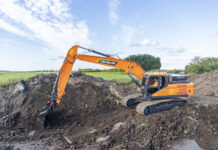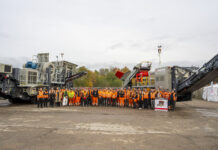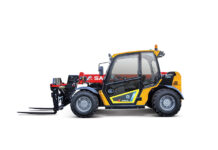
Dan Gilkes reports on JCB’s new JZ141 reduced tailswing tracked excavator
JCB has launched a 15-tonne reduced-swing crawler excavator that requires no DPF, no AdBlue and no after-treatment to meet current EU Stage IIIB and US Tier 4 Final emissions standards. This has been achieved by installing a 74hp (55kW) version of the award-winning JCB EcoMAX diesel engine, in place of the more powerful 108hp (81kW) found in the previous JZ140.
There is more to the new JZ141 than a simple engine swap however, as JCB’s engineers have devised a way of maintaining the hydraulic pressures and flows of the more powerful model, while also delivering major fuel savings. The EcoMAX is a high-torque, low-rev engine and it has been possible to use that torque to drive larger 130 litre/min hydraulic pumps, but at a lower engine speed, to maintain overall hydraulic performance.
The new machine runs at a maximum engine speed of just 1,800rpm, down from 2,050rpm on the previous JZ140. This contributes to as much as a 20% fuel saving over the more powerful model, along with a noticeable drop in engine noise, with in-cab sound levels down to just 70dB.

The use of this 55kW engine is well proven, as JCB has successfully equipped a number of its larger Loadall telescopic handlers with the EcoMAX diesel. The company also introduced the JS131 conventional tailswing excavator with the 74hp (55kW) engine alongside the standard JS130, which boasts the 108hp (81kW) motor. In both cases customers have found that performance remains strong and there have been substantial fuel and cost savings for end users.
Unlike the conventional tailswing JS131, JCB has dropped the higher horsepower JZ140 in favour of the new excavator. It’s fair to assume that most customers will opt for the convenience and lower operating cost of the JZ141, particularly as the majority of sales will be to rental companies.

JCB admits that in an ultimate heavy digging test the JZ141 would be slightly less productive than its higher horsepower predecessor. However few customers will use a 15-tonne compact radius excavator in a mass excavation operation. The machine is more likely to be operated in confined urban site conditions, where outright breakout forces are not a primary concern.
The simplicity of the engine installation and the fact that there is no requirement for AdBlue or DPF regeneration, will probably be far more important considerations for customers than ultimate digging power.
That’s not to say that the JZ141 is not competitive though; it has little trouble digging and loading in heavy materials and maintains impressive lifting performance, handling concrete pipes at full reach with ease. Indeed as the JZ141 sits on the same undercarriage as the JS131LC, the machine boasts impressive stability, even with the reduced counterweight design.

The JZ141 comes with a 4.7m monoboom as standard plus a wide choice of dipper arms, including the usual 2.1m, 2.5m and 3.0m lengths. These are joined by a new 2.7m dipper, designed for use with a tilt-rotator, where it provides similar reach to the 3.0m arm.
There are three tipping links available, offering a lifting lug, a hook or no hook, while JCB’s latest quickhitch can be supplied from the factory. A full range of auxiliary pipe options is available for varying attachments and the JZ141 can be supplied with JCB’s Advanced Tool Select system. This allows the operator to pre-set up to 10 attachment flows and pressures from the monitor in the cab.

The reduced tailswing is 29% shorter than the conventional JS130, allowing the upperstructure to turn almost within the tracks. There is a choice of track widths, from 500mm up to low ground pressure 900mm pads. To work with the optional dozer blade though, you’ll need the mid-range 700mm pads for the correct overall width.
There is a heavy duty undercarriage option, using the track frames from the larger JS160 excavator, but this can only be had with 600-800mm pads. Customers that fit rubber track blocks to the standard tracks could operate the machine within a single carriageway, in place of a wheeled excavator.
Service and maintenance access and operator’s cab size are generally where the compromises have to be made with a reduced swing machine, but not it seems with the JZ141. There are wide opening doors for the cooling pack, air filter and batteries on the one side and to provide access to the remote oil, fuel and hydraulic filters on the other of the machine.
The flat engine canopy provides a good view to the top of the EcoMAX, with a step in front of the engine for easier service access. As there is no bulky exhaust after-treatment to fit in, the engine canopy doesn’t intrude on the view to the rear of the machine like some competitors.
JCB has also provided an access hole in the centre of the counterweight casting, covered by a steel plate beneath the JCB logo. You can reach right through from the back of the machine to access the engine, without having to remove the counterweight itself.

The boom foot and dipper mounting pins come with graphite impregnated bushings, permitting greasing intervals of up to 1,000 hours. Engine oil and filters are changed at 500 hour intervals, with the hydraulic oil filter at 1,000 hours. The hydraulic oil itself can be used for up to 5,000 hours.
All daily checks of oil and coolant levels can be made using the in-cab monitor and there is no requirement for AdBlue or costly special oils for the engine. JCB dealers can also recalibrate the EcoMAX engine for export markets with lower grade fuels, potentially boosting residual appeal.
The JZ141 uses the same cab as JCB’s larger conventional swing models, with plenty of room to get comfortable and storage space behind the seat for bags and coats. A configurable 7″ colour multi-function display screen provides all of the information that you need and acts as a monitor for the rear-view camera.

JCB’s LiveLink telematics system has been enhanced to offer accurate fuel consumption and operating mode information, allowing managers to see how the machine is being used.
Geofencing features will also be useful for rental companies monitoring unauthorised use of the machine on site.
JCB has proven the effectiveness of this 74hp (55kW) EcoMAX engine in its Loadalls, conventional crawler excavators and now in this reduced swing machine.
Emissions standards will change again in 2019-20, with the introduction of EU Stage V standards. But for now at least, there should be plenty of customer demand for such a competitive machine with no DPF, no AdBlue and no after-treatment.











